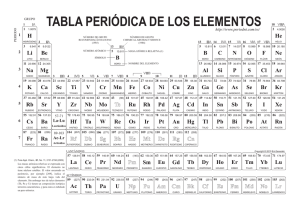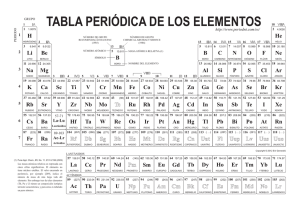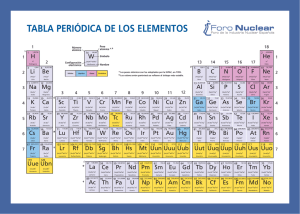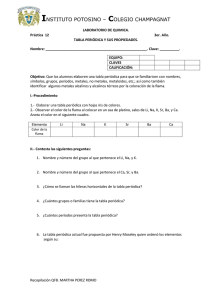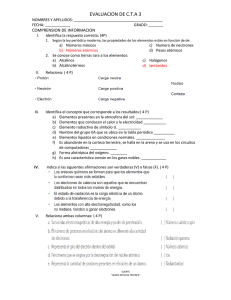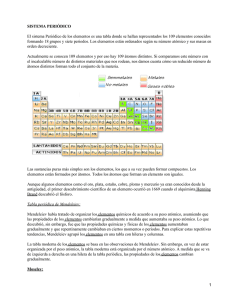El lenguaje químico
Anuncio
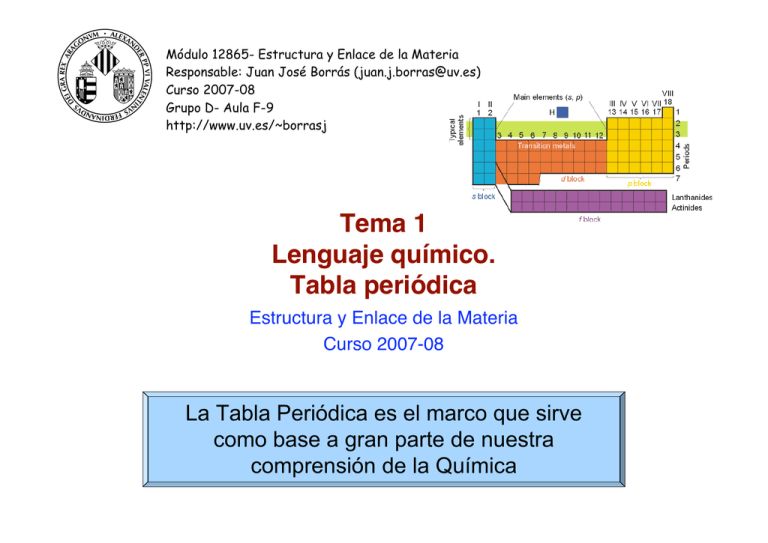
Módulo 12865- Estructura y Enlace de la Materia Responsable: Juan José Borrás (juan.j.borras@uv.es) Curso 2007-08 Grupo D- Aula F-9 http://www.uv.es/~borrasj Tema 1 Lenguaje químico. Tabla periódica Estructura y Enlace de la Materia Curso 2007-08 La Tabla Periódica es el marco que sirve como base a gran parte de nuestra comprensión de la Química Esquema del tema Antecedentes de la tabla periódica. Organización de la tabla periódica moderna EQEM Curso 2007-08 T-2 Mendeleev and the Periodic Table Mendeleev's genius can be appreciated when we remember that only 62 elements were known when he formulated the periodic table. To bring similar elements together in the table, he ignored the atomic masses of a few elements, suggesting that they were incorrect, and he was forced to leave some gaps, which he predicted would be occupied by elements that had not then been discovered, some of whose properties he ventured to predict. It was not until some of these elements were discovered and shown to have properties that agreed well with Mendeleev's predictions that many chemists overcame their initial skepticism about the value of the periodic table. Moreover, the later redetermination of some atomic masses, the discovery of isotopes, and the realization that the order of the elements is based on atomic numbers rather than atomic masses, provided justification for the cases in which Mendeleev ignored the order of atomic masses. Many modifications of Mendeleev's original table have been suggested, but the table in Figure 1.1 (Periodic Table), which is widely used today, is not very different from that originally proposed by Mendeleev; many additional elements have been incorporated, but without changing the overall structure of the original table. The periodic table not only gave chemists a very useful classification of the elements, but it played a vital role in the elucidation of the structure of atoms and the understanding of valence. Today it still remains a most useful working tool for the chemist. Extraído del libro (Chemical Bonding and Molecular Geometry. From Lewis to Electron densities. R. J. Gillespie y P. L.A. Popelier) Antecedentes históricos J. Döbereiner (1817) Similitudes entre conjuntos de tres elementos (Tríadas de elementos): Ca, Sr, Ba; Cl, Br, I; S, Se, Te. Hacia 1850 se habían identificado 20 tríadas J. Newlands (1863) Ordenó los elementos por su masa atómica, y observó que se repite un ciclo de propiedades comunes cada 8 elementos. Ley de las octavas (escala musical). J. Döbereiner (1780-1849) Mendeleiev y Meyer (1869): Meyer basó su organización en el volumen atómico Sugieren el mismo patrón organizando los elementos conocidos en grupos de 8 elementos en orden de masa atómica creciente. J. Newlands (1837-1898) EQEM Curso 2007-08 T-4 La ley periódica de Mendeleiev La ley periódica: Cuando los elementos se organizan en orden creciente de sus masas atómicas, algunos conjuntos de propiedades se repiten periódicamente EQEM Curso 2007-08 T-5 1869 EQEM Curso 2007-08 T-6 Propuestas de Mendeleiev a. La periodicidad de las propiedades es inherente a la distribución. b. La distribución se corresponde con las valencias de los elementos. c. Las características de los elementos quedan determinadas por el valor de sus pesos atómicos. d. Los errores en los pesos atómicos pueden corregirse a partir de la posición del elemento en la tabla. e. Los elementos cuyas propiedades son parecidas, o tienen pesos atómicos parecidos o aumentan regularmente. EQEM Curso 2007-08 T-7 Tabla Periódica de Mendeleiev — = 44 — = 68 — = 72 — =100 A fin de asegurar que los patrones de propiedades se ajustaran a la estructura de la tabla fue necesario dejar espacios vacíos. Esos espacios corresponderían a elementos desconocidos. EQEM Curso 2007-08 T-8 Éxitos de Mendeleiev Dejó huecos que corresponderían a elementos por descubrir: 44, 68, 72, y 100 (Sc, Ga, Ge y Tc) Corrigió las masas atómicas de algunos elementos (I, Te, In, U). EQEM Curso 2007-08 T-9 Problemas Siguiendo el orden de masas atómicas crecientes los elementos no siempre encajaban en el grupo con propiedades coincidentes. Tuvo que invertir el orden de Ni y Co, Y y Te Se estaban descubriendo elementos nuevos como holmio y samario para los que no había hueco previsto. En algunos casos elementos del mismo grupo eran muy diferentes en cuanto a su reactividad química. Grupo 1: contiene metales alcalinos (muy reactivos) y metales de acuñación (Cu, Ag y Au; muy poco reactivos) Para establecer un grupo, al menos se tenía que conocer un elemento: No se conocían los gases nobles y no se dejó espacio para ellos EQEM Curso 2007-08 T-10 Contribución de Moseley Llevó a cabo experimentos con Rayos X, descubriendo que: H. Moseley 1913 (1887-1915) murió a los 28 años Al incidir un haz de RX en un elemento, los átomos de éste emiten rayos X de una frecuencia característica de cada elemento. Las frecuencias están correlacionadas con las cargas nucleares Z. Permitió predecir nuevos elementos [Z=43 (descubierto en 1937), 61(1945), 75(1925)]. Probó la bondad de la ley periódica entre Z=13 y 79 afirmando que NO podría haber otros elementos en esta región. ! = A( Z " b) 2 Encontró que, al ordenar los elementos con respecto a Z, se eliminaban las irregularidades de la tabla de Mendeleiev basada en la masa atómica y se definían con exactitud los huecos para los que era necesario encontrar elementos La Ley Periódica de Moseley establece que las propiedades físicas y químicas de los elementos son funciones periódicas de sus números atómicos. T-11 Curso 2007-08 EQEM Organización de la Tabla Periódica Moderna Grupos: Periodos: Bloques: columnas 1-18 filas 1-7 s, p, d, f EQEM Curso 2007-08 T-13 Grupos de elementos Grupos Grupos 1, 2, 13-18 Nombre específico / Nombre tradicional Elementos Configuración electrónica Elementos representativos (grupos principales) Grupos 1 y 2 Grupo 1 Grupo 2 Elementos del bloque s Metales alcalinos Metales alcalino-térreos Li, Na, K, Rb, Cs, Fr Be, Mg, Ca, Sr, Ba, Ra ns1 (n= 2 -7) ns2 (n= 2 -7) Grupos 13-18 Grupo13 Grupo14 Grupo15 Grupo16 Grupo17 Grupo18 Elementos del bloque p Elementos del grupo del boro Elementos del grupo del carbono Pnictógenos Calcógenos Halógenos Gases nobles B, Al, Ga, In, Tl C, Si, Ge, Sn, Pb, Uuq N, P, As, Sb, Bi O, S, Se, Te, Po, Uuh F, Cl, Br, I, At He, Ne, Ar, Kr, Xe, Rn, Uuo ns2 np1 (n= 2 -7) ns2 np2 (n= 2 -7) ns2 np3 (n= 2 -7) ns2 np4 (n= 2 -7) ns2 np5 (n= 2 -7) ns2 np6 (n= 2 -7) Sc, Ti, V, Cr, Mn, Fe, Co, Ni, Cu, Zn Y, Zr, Nb, Mo, Tc, Ru, Rh, Pd, Ag, Cd La, Hf, Ta, W, Re, Os, Ir, Pt, Au, Hg Ac, Rf, Db, Sg, Bh, Hs, Mt, Ds, Rg, Uub La, Ce, Pr, Nd, Pm, Sm, Eu, Gd, Dy, Ho, Er, Tm, Yb, Lu Ac, Th, Pa, U, Np, Pu, Am, Cm, Bk, Cf, Es, Fm, Md, No, Lr 4s2 3d1- 4s2 3d10 5s2 4d1- 5s2 4d10 6s2 5d1- 6s2 5d10 7s2 6d1- 7s2 6d10 Grupos 3-12 Grupos f Elementos del bloque d Elementos de transición Primera serie de transición Segunda serie de transición Tercera serie de transición Cuarta serie de transición Lantánidos Actínidos EQEM Curso 2007-08 4f1 - 4f14 5f1 - 5f14 T-14 Tabla Periódica Moderna Forma extra larga H He 1 Li Be B C 2 Na Mg Al Si 3 K Ca Sc Ti V Cr Mn Fe Co Ni Cu Zn Ga Ge 4 Rb Sr Y Zr Nb Mo Tc Ru Rh Pd Ag Cd In Sn 5 Cs Ba La Ce Pr Nd Pm Sm Eu Gd Tb Dy Ho Er Tm Yb Lu Hf Ta W Re Os Ir Pr Au Hg Tl Pb 7 Fr Ra Ac Th Pa U Np Pu Am Cm Bk Cf Es Fm Md No Lr Rf Db Sg Bh Hs Mt Uun Uuu Uub N O F Ne P S Cl Ar As Se Br Kr Sb Te I Xe Bi Po At Rn 18 Forma larga 1 2 H 1 Li Be 2 Na Mg 3 4 5 6 7 8 9 10 11 3 K Ca Sc Ti V Cr Mn Fe Co Ni 4 Rb Sr Y Zr Nb Mo Tc Ru Rh 5 Cs Ba Lu Hf Ta W Re Os 7 Fr Ra Lr Rf Db Sg Bh Lantánidos La Ce Pr Nd Actínidos Ac Th Pa U EQEM 13 14 15 16 17 He B C N O F Ne 12 Al Si P S Cl Ar Cu Zn Ga Ge As Se Br Kr Pd Ag Cd In Sn Sb Te I Xe Ir Pr Au Hg Tl Pb Bi Po At Rn Hs Mt Uun Uuu Uub Pm Sm Eu Gd Tb Dy Ho Er Tm Yb Np Pu Am Cm Bk Cf Es Fm Md No Curso 2007-08 T-15 Estructura de la Tabla Periódica Secuencia de ocupación de los orbitales electrónicos El número de elementos de cada periodo corresponde al número de electrones necesarios para llenar esos orbitales Representativos 2s Representativos 1s 2p 3s Transición 3p 4s 3d 4p 5s Transición interna 4d 5p 6s 4f: Lantánidos 5d 6p 7s 5f: Actinidos 6d EQEM Curso 2007-08 T-16 Tabla periódica de los elementos Los elementos químicos se ordenan según su número atómico. Los elementos de una columna constituyen un grupo. Los elementos de una fila horizontal constituyen un periodo 18 1 2 1 Li Be 2 Na Mg 3 K 4 Rb H 8 9 16 17 He B C N O F Ne Al Si 6 Ca Sc Ti V Cr Mn Sr Y Zr Nb Mo Tc Ru Rh Pd Ag Cd In 5 Cs Ba Lu Hf Ta Re Os Ir Tl 7 Fr Lr Rf Db Sg Bh Hs Mt Ds Rg Fe Co 10 11 P S Cl Ar Ni Cu Zn Ga Ge As Se Br Kr Sn Sb Te I Xe Pb Po At Rn Pr 12 15 5 W 7 14 4 Ra 3 13 Au Hg Bi Uub http://www.webelements.com/ Lantánidos La Ce Pr Nd Pm Sm Eu Gd Tb Dy Ho Actínidos Ac Pa U Cf Th Np Pu Am Cm Bk EQEM Curso 2007-08 Er Tm Yb Es Fm Md No T-17 Grupos de elementos Los elementos de una columna constituyen un grupo. grupo 1 : Alcalinos 18 grupo 2: Alcalinotérreos grupos 3-11: Transición grupos 12, 13, 14, 15, 16 1 2 H 13 14 15 16 17 He 1 Li Be B C N O F Ne 2 Na Mg 3 4 5 6 7 8 9 10 11 12 Al Si P S Cl Ar 3 K Ca Sc Ti V Cr Mn Fe Co Ni Cu Zn Ga Ge As Se Br Kr 4 Rb Sr Y Zr Nb Mo Tc Ru Rh Pd Ag Cd In Sn Sb Te I Xe 5 Cs Ba Lu Hf Ta W Re Os Ir Pr Au Hg Tl Pb Bi Po At Rn 7 Fr Ra Lr Rf Db Sg Bh Hs Mt Ds Rg Uub Lantánidos La Ce Pr Nd Pm Sm Eu Gd Tb Dy Ho Er Tm Yb Actínidos Ac Th Pa U Np Pu Am Cm Bk Cf Es Fm Md No grupo 17: Halógenos Los lantánidos y actínidos no utilizan designaciones numéricas. grupo 18: Gases nobles La IUPAC recomienda utilizar los términos lantanoides y actinoides para referirnos a estos grupos EQEM Curso 2007-08 T-18 Bloques de elementos s (grupos 1-2) Elementos representativos p (grupos 13-18) d (grupos 3-11) f (lantánidos y actínidos) 18 1 2 1 Li Be 2 Na Mg 3 4 5 6 7 8 9 10 11 3 K Ca Sc Ti V Cr Mn Fe Co Ni 4 Rb Sr Y Zr Nb Mo Tc Ru Rh 5 Cs Ba Lu Hf Ta W Re Os 7 Fr Ra Lr Rf Db Sg Bh Lantánidos La Ce Pr Nd Actínidos Ac Th Pa U EQEM H 13 14 15 16 17 He B C N O F Ne 12 Al Si P S Cl Ar Cu Zn Ga Ge As Se Br Kr Pd Ag Cd In Sn Sb Te I Xe Ir Pr Au Hg Tl Pb Bi Po At Rn Hs Mt Ds Rd Uub Pm Sm Eu Gd Tb Dy Ho Er Tm Yb Np Pu Am Cm Bk Cf Es Fm Md No Curso 2007-08 T-19 Presentemos a los elementos químicos 1 2 3 4 5 6 7 8 9 10 11 12 13 14 15 16 17 H? 18 He Li Be B C N O F Ne Na Mg Al Si P S Cl Ar K Ca Sc Ti V Cr Rb Sr Y Zr Nb Mo Tc Cs Ba La* Hf Ta W Fr Ra Ac* Rf * Db Sg Mn Fe Co Ni Cu Zn Ga Ge As Se Br Kr Ru Rh Pd Ag Cd In Sn Sb Te I Xe Re Os Ir Pt Au Hg Tl Pb Bi Po At Rn Bh Hs Mt Ds Rg Uub * Ce Pr Nd Pm Sm Eu **Th Pa U Np Pu Uuq Uuh Gd Tb Dy Ho Er Tm Yb Lu Am Cm Bk Cf Es Fm Md No Lr Uuo http://chemlab.pc.maricopa.edu/periodic/lyrics.html ``It's simply the names of the chemical elements set to a possibly recognizable tune. ``There's holmium and helium and hafnium and erbium ``There's antimony, arsenic, aluminum, selenium, And phosphorous and francium and fluorine and terbium And hydrogen and oxygen and nitrogen and rhenium And nickel, neodymium, neptunium, germanium, And iron, americium, ruthenium, uranium, Europium, zirconium, lutetium, vanadium And lanthanum and osmium and astatine and radium And gold, protactinium and indium and gallium (inhale) And iodine and thorium and thulium and thallium. ``There's yttrium, ytterbium, actinium, rubidium And boron, gadolinium, niobium, iridium And strontium and silicon and silver and samarium, And bismuth, bromine, lithium, beryllium and barium. And manganese and mercury, molybdinum, magnesium, Dysprosium and scandium and cerium and cesium And lead, praseodymium, and platinum, plutonium, Paladium, promethium, potassium, polonium, and Tantalum, technetium, titanium, tellurium, (inhale) And cadmium and calcium and chromium and curium. ``There's sulfur, californium and fermium, berkelium And also mendelevium, einsteinium and nobelium And argon, krypton, neon, radon, xenon, zinc and rhodium ``Isn't that interesting? And chlorine, carbon, cobalt, copper, I knew you would. Tungsten, tin and sodium. I hope you're all taking notes, because there's gonna be a short quiz next period. ``These are the only ones of which the news has come to Harvard, And there may be many others but they haven't been discovered.'' Los primeros periodos 1 2 3 H? 4 5 6 7 8 9 10 11 12 13 14 15 16 17 1º período (Z=1-2) Li Be Na Mg K Ca He 2º período (Z=3-10) 3º período (Z=11-18) Sc Ti V Cr Mn Fe 18 Co Ni Cu Zn B C N O F Ne Al Si P S Cl Ar Ga Ge As Se Br Kr 4º período (Z=19-36) 1ª serie transición EQEM Curso 2007-08 T-23 5º periodo 5º período (Z=37-54) 1 2 3 4 5 6 7 8 9 10 11 12 13 14 15 16 17 18 1º H 2º Li Be B C N O F Ne 3º Na Mg Al Si P S Cl Ar 4º K Se Br Kr 5º Rb Sr He Ca Sc Y Ti V Cr Mn Fe Zr Nb Mo Tc Co Ni Cu Zn Ga Ge As Ru Rh Pd Ag Cd In Sn Sb Te I Xe 2ª serie transición EQEM Curso 2007-08 T-24 6º periodo 6º período (Z=55-86) 1 2 3 4 5 6 7 8 9 10 11 12 13 14 15 16 17 1º 18 He 2º Li 3º Na Mg 4º K 5º Rb Sr 6º Cs Ba La Be 3ª serie transición Ca Sc Y Ti V Zr Nb Mo Tc Hf Ta Ce Cr Pr W Mn Fe Co Ni C N O F Ne Al Si P S Cl Ar Se Br Kr Ga Ge As Ru Rh Pd Ag Cd In Re Os Ir Nd Cu Zn B Pt Pm Sm Eu Au Hg Tl Gd Tb Dy Sn Sb Te Pb Bi Ho Er I Po At Tm Yb Xe Rn Lu Lantánidos EQEM Curso 2007-08 T-25 7º periodo 1 2 3 H? 4 5 6 7 8 9 10 11 12 13 14 15 16 17 18 He 7º período (Z=87-118) Li Be B C N O F Ne Na Mg Al Si P S Cl Ar K Ca Sc Ti V Cr Rb Sr Y Zr Nb Mo Tc Cs Ba La* Hf Ta W Fr Ra Ac* Rf * Db Actínidos Mn Fe Co Ni Cu Zn Ga Ge As Se Br Kr Ru Rh Pd Ag Cd In Sn Sb Te I Xe Re Os Ir Pt Au Hg Tl Pb Bi Po At Rn Sg Bh Hs Mt Ds Rg Uub * Ce Pr Nd Pm Sm Eu **Th Pa U Np Pu EQEM Uuq Uuh Uuo Gd Tb Dy Ho Er Tm Yb Lu Am Cm Bk Cf Es Fm Md No Lr Curso 2007-08 T-26 7º periodo (incompleto) 7º 1 2 3 Fr Ra Ac 4 5 6 7 8 9 Rf Db Sg Bh Hs Mt 10 11 12 13 Ds Rg Uub ¿? 14 15 Uuq ¿? 16 17 18 Uu ¿? h Uu o • Z Nombre Símbolo •104 Rutherfordio Rf •105 Dubnio Db •106 Seaborgio Sg •107 Bohrio Bh • Z Nombre •108 Hassio Hs •112 Ununbio Uub •109 Meitnerio Mt •113 Ununtrio Uut •110 Darmstadtio Ds •114 Ununquadio Uuq •111 Roentgenio Rg •116 Ununhexio Uuh •118 Ununoctio Uuo EQEM Curso 2007-08 Símbolo T-27 Elementos naturales y artificiales Se han identificado 109 elementos químicos 81 Elementos naturales con algún isótopo estable respecto a desintegración radiactiva Desde Z=1 a Z=83 (Bi) Excepciones Z=43 Tc (sintético) Z=61 Pm (sintético) Otros elementos cuyos isótopos son radiactivos pero que existen en la Naturaleza De Z=84 (Po) a Z=92 (U) Th y U bastante abundantes (vida media 108-109 años) Elementos sintéticos 18 Z = 43 Tc (sintético) Z = 61 Pm (sintético) Z = 93(Np)-109 (Mt) 1 2 1 Li Be 2 Na Mg 3 Z= 112, 114, 116 y 118 ?? radiactivos EQEM K H 3 8 C N O F Ne 10 11 12 Al Si P S Cl Ar Cu Z n Ga Ge As Se Br Kr 4 5 6 V Cr Mn F e Co Ni 4 Rb Sr 5 Cs Ba Lu Hf T a W Re Os 7 F r Ra Lr 9 B Ca Sc T i Y 7 13 14 15 16 17 He Z r Nb Mo T c Ru Rh Pd Ag Cd Ir Rf Db Sg Bh Hs Mt In Pr Au Hg T l Sn Sb T e Pb Bi I Xe Po At Rn Uu Uu Uu n u b Lantánidos La Ce Pr Nd Pm Sm Eu Gd T b Dy Ho Er T m Yb Actínidos Ac T h Pa Curso 2007-08 U Np Pu Am Cm Bk Cf Es F m Md No T-28 ¿Te atreves a rellenarla? 1 2 bloque s 3 4 5 6 7 8 9 10 11 12 13 14 15 16 17 18 bloque d bloque p 1 2 3 4 5 6 7 bloque f EQEM Curso 2007-08 T-29 Fin

